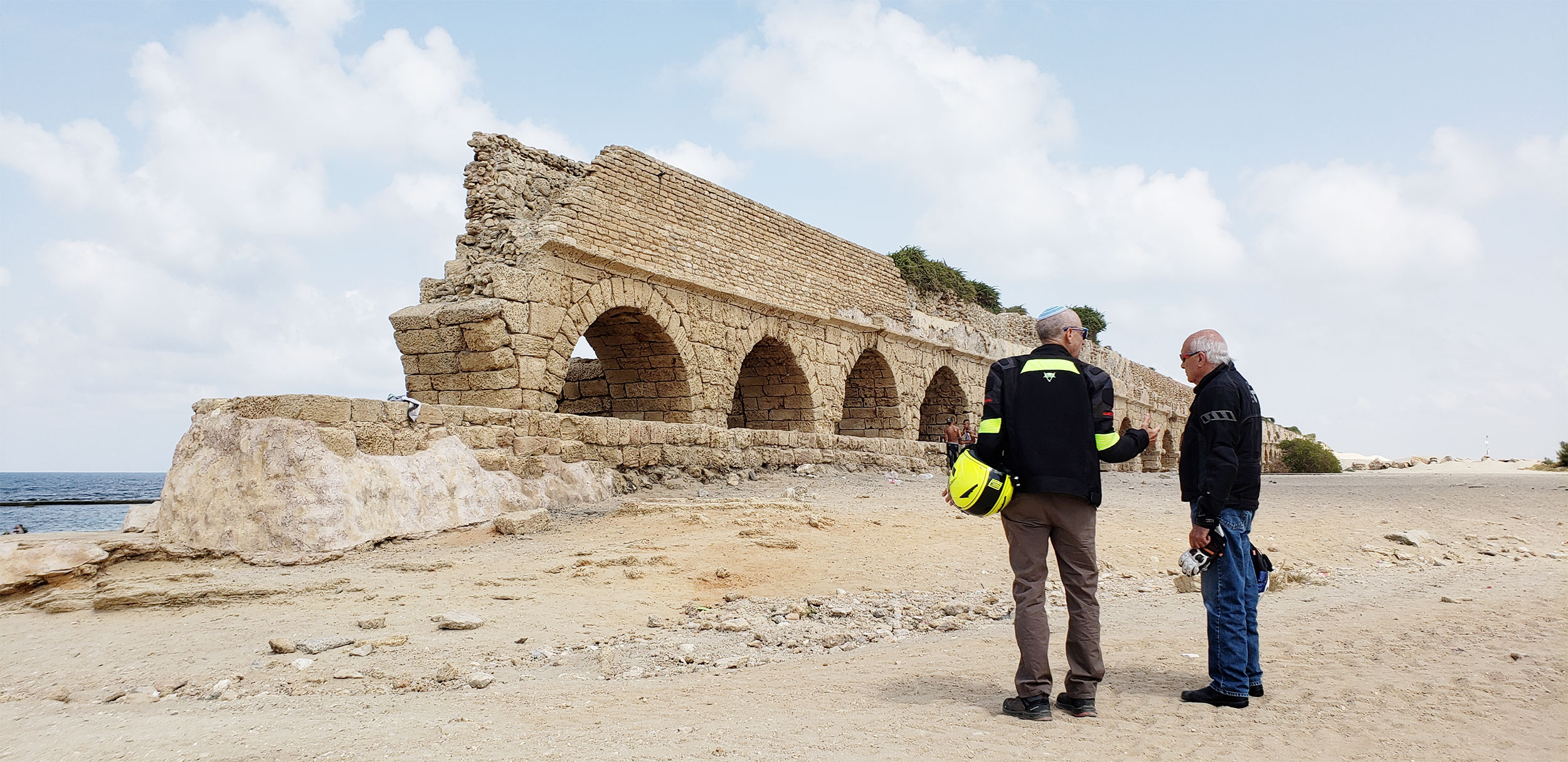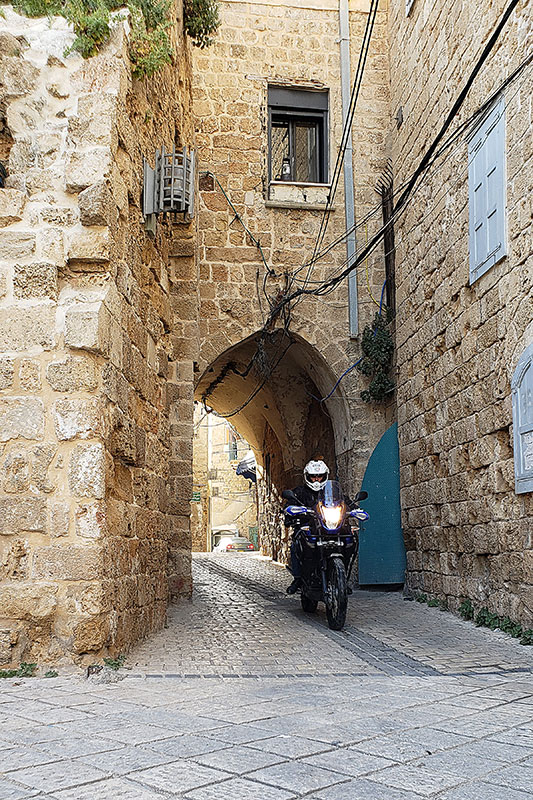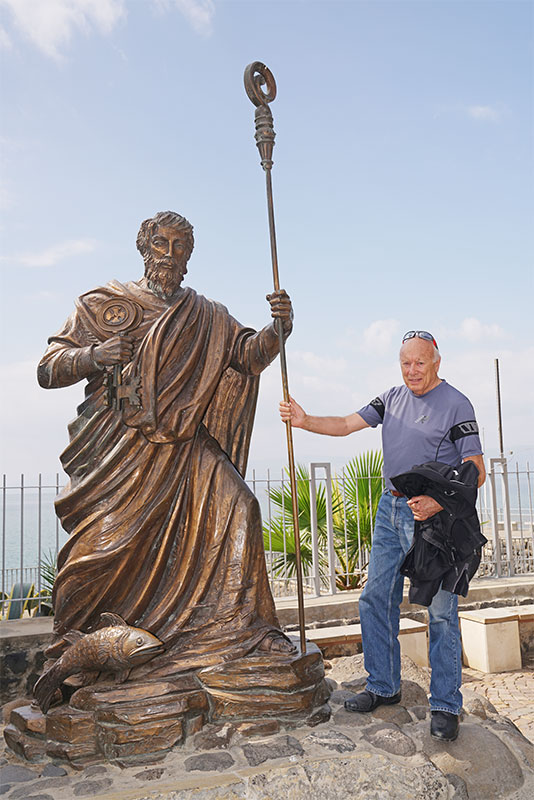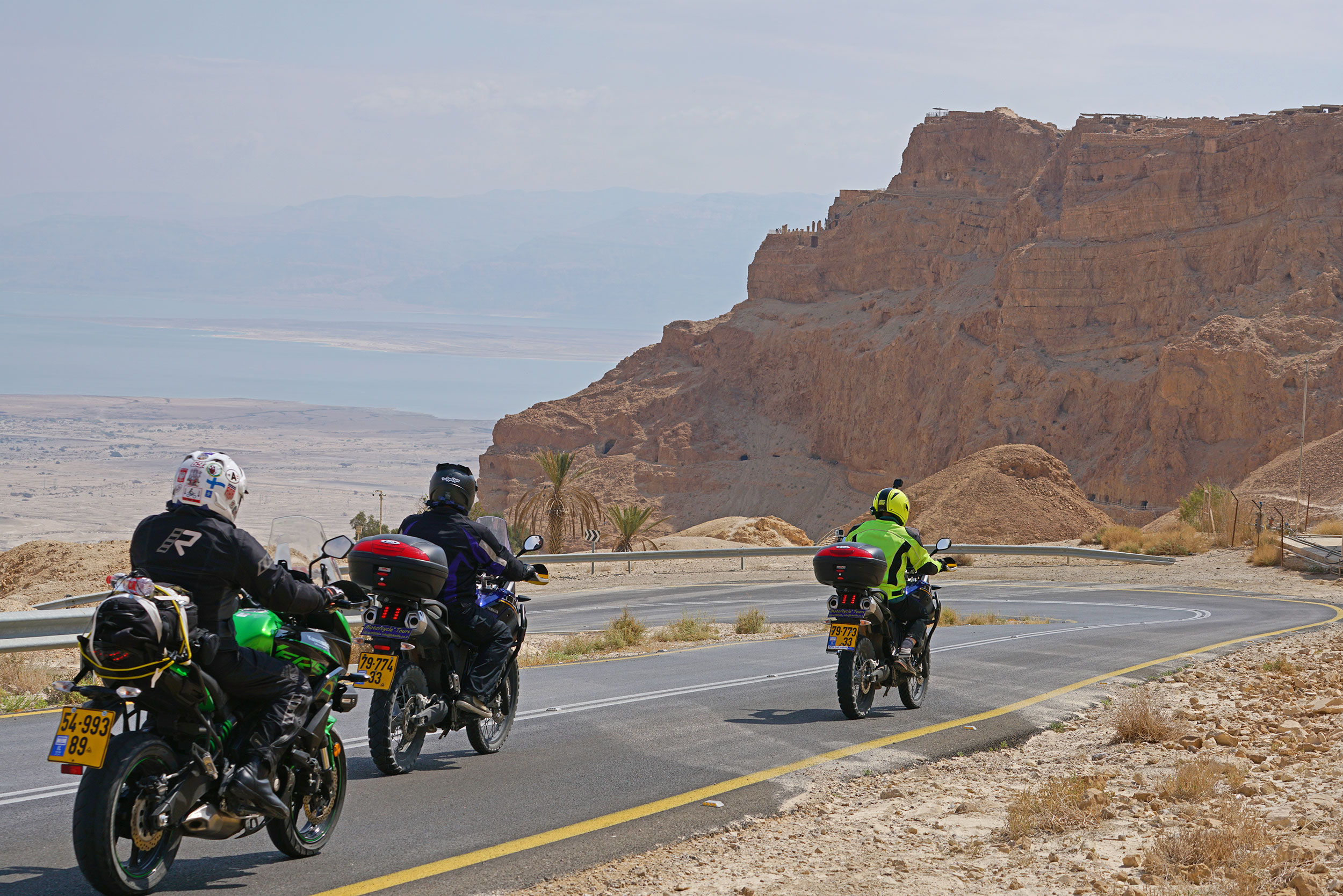American Motorcyclist July 2018
Riding Israel: Redefining Expectations
Six Days, 1,200 Miles, A Lifetime Of Discovery

The Romans were known for their ability to build roads and aqueducts, which served them well in the countries they conquered. This example built by King Herod in the first century brought water from the springs of Shummi 10 kilometers to the coastal city of Caesarea.
By Peter Starr
Being forthright, I have to admit that Israel was not on my bucket list for countries to ride for my coming book. Given the general political status in the Middle East, I was concerned about various perceived dangers.
Were it not for my nephew—who has been there several times—and motorcycle industry executive Ken Engelman—who encouraged me to go on this trip he had planned with his friend Duby Nevo—I might still hold these misinformed opinions.
Watching the news is not the best way to form opinions about countries or people! Let me say, up front, I had one of the best ride experiences, full of so much interesting riding, scenery, history and diverse culture that my fears and opinions changed 180 degrees.
Duby Nevo operates Bikelife Motorcycle Tours in Israel, and he is a government-certified tour guide, which means he is a competent motorcycle rider and he has an extraordinary knowledge of Israeli history. I am a bit of a history buff, so accurate information is important to me. It adds spice to my motorcycle journey.
While Israel embraces a very traditional culture, it is a modern technical society that lacks for nothing.
Imagine being able to visit the topography of Montana, Idaho, Utah and Southern California all in an area the size of New Jersey, with a large population (about 8.5 million), but with more history within its borders than most other countries its side.
My discovery started in perfect weather by riding north from our base at Netanya, along the coast to the town of Caesarea. I quickly got used to seeing place names that have been in my vocabulary since childhood, particularly because I attended Sunday school. I might have forgotten what happened in a particular place, but the names were emblazoned in my memory.
There are huge artifacts from 2,000 and 3,000 years ago everywhere, built by generations long forgotten—the aqueduct at Caesarea being only the first of many I would study.
We followed the two main coastal roads north, Hwy. 2 and Hwy. 4, intercity four-lane highways leading from Gaza through Tel Aviv all the way to the Lebanese border. It is favorable to take these roads if you are on a tight schedule as we were. There was so much to see in the six days I had allotted for this tour.
Intercity, we stayed on the coast on Hwy. 2, branching off to see the sights in the port of Haifa. More than 2,000 years ago, Haifa was a coastal fishing village. Now, it is a major port on the Mediterranean Sea. It is also the home of the Bahai faith, which started in the early 1800s, and their beautiful gardens.
Tour buses abound, many containing pilgrims of various faiths looking to visit the birth sites of their belief.
Visiting Acre & Tiberias

The 28-foot-thick walls of the Templar Fortress at Acre are best appreciated when riding through archways that are just wide enough for a motorcycle.
Being on a motorcycle is a definite advantage in getting to a particular site, and for parking. As in other countries, being a rider makes you a source of conversation and sometimes brings a few perks. Splitting lanes and weaving through traffic is allowed in Israel, and we did that, as Duby led us to the ancient walled city of Acre (Akko).
Some of the best hummus I had ever tasted re-energized us for the walk through the tunnels and narrow passageways of the old walled city.
There are tunnels here that were engineered by the Knights Templar of the Crusades fame in the 12th century and used by every invading force that followed. This UNESCO World Heritage Site has been the location of a continuous settlement since the Phoenician period.
The markets in the narrow passageways have been trading sites since the earliest of times and remain a great place to bargain for local wares. Bargaining is almost a sport here.
Not too much farther north is the Lebanese border, which sits atop the white cliffs of Rosh Hanikra, through which the British built a railroad tunnel from Haifa to Beirut to ship supplies north from Egypt. The tracks and tunnel, although still visible, were blocked to stop the Lebanese army from invading from the north in 1948.
The border is not a crossing, but a closed gate with a single armed soldier on the other side.
We turned back and headed east along Hwy. 899, toward the Sea of Galilee and the town of Tiberias, through beautiful sweeping hill country that made the late afternoon ride quite stimulating.
Biblical names were presenting themselves with increasing frequency, each with a well-documented history. Day One ended as the darkness closed in, obscuring the view across the water toward the Golan Heights, and we celebrated it with a wonderful dinner at Deck’s on the shore of the Sea of Galilee.
History & Prophecy
Up at dawn and an early hearty breakfast, before looking in on a local museum to see a fishing boat that had been carbon dated to the time of Jesus.
It was discovered in the mud as the waters of the Sea of Galilee receded. Now restored, it serves as a stimulus for the mind while cogitating about the fishermen of Galilee.
The day warmed as we headed north and around the sea to places where Jesus preached and where the original churches and synagogues still stand as witnesses to that time.
The roads were perfect for motorcycles, as the blasts of riding added to the marvels of historic discovery.
St. Peter’s house in Capernaum, the Church of Multiplication of the Loaves and Fish at Tabgha and the Church of Heptapegon all helped paint a picture of life in biblical times. It is mind blowing to realize that I stood on the same land that has been walked on continuously for over 3,000 years. These names were not just names being spewed forth at Sunday school; they are real places with definable history.

The 12-foot bronze statue of St. Peter at Capernaum. He holds the key to the Kingdom of Heaven.
We rode north along a dirt road that paralleled the Jordan River, finally taking a fork down to the river, allowing us to wash ourselves at a crossing site of this legendary waterway.
We went back onto the twisty, two-lane blacktop and over the river into the Golan Heights and the small town of Katsrin for lunch. It is not unusual to see armed soldiers, mainly young men and women, serving their country through mandatory national service. They are friendly and will generally pose for a photograph, if you ask politely. And yes, in case you have to ask, those rifles are loaded. They are alert and prepared.
More swift riding followed along roads that offered spectacular scenery, north to the Quneitra valley alongside the Syrian border. It is here we found the bombed and abandoned building that was the headquarters of the Syrian ground forces before the 1973 Yom Kippur War.
You can wander around on top of this building, looking directly into Syria and at the border, alongside the United Nations Peace Keeping Force post.
From the top of this building, and from the top of the nearby Mount Bental, it has been possible even recently to watch the battles 50 miles away between the Syrian forces and the rebels.
We stayed a while, then rode to the top of Mount Bental for coffee and a better view of the Syrian border from the deep recesses of the concrete bunkers.
This is a popular tourist spot, with many coaches stopping to allow their passengers a first-rate view to the north and east. As much as we were removed from any possibility of conflict, it is still an immediate reminder that Israel maintains a constant vigil as the war to the north continues.
Our destination that evening was the coastal town of Netanya, so we headed back to Katsrin for a caffeine top up before riding south through the Golan Heights to the south end of the Sea of Galilee and another great photo op.
Then we wound our way toward the setting sun along roads that, quite honestly, needed a lot more of my time than I had to give.
Changing Landscapes
Day Three began in light rain, as we headed south toward the Negev Desert.
We blitzed though the unusually cold spell, down to Hwy. 40 and Be’er Sheva, before turning east for our lunch stop in Dimona. At this point, I should say all the food we were served was excellent: fresh, simple, healthy and fitting to my strict diet.
Topographically, this was totally different from the Israel I had experienced. This is the desert of camels and golden sand, of stark mountains and stunning vistas. But, like the North, the roads provide spectacular motorcycle riding, with one range of hills opening to reveal yet another desert panorama.
Only very light traffic shared the road with us to Yeruham and on to the stunning Ha-Gadol crater. This crater, although not the largest, is a geological form unique to Israel and Sinai. This kind of crater, or makhteshim, was not formed by meteors, but by erosion and, as such, offers different shapes and colors as the erosion progressed.
Looking across the sculptured desert really called for more time for contemplation or meditation than we had available. So, onward we rode to the Scorpion Pass, a 21-mile stretch of road with 18 switchbacks from its height in the northwest to its base at Ir Ovot in the southeast. It was an exciting ride along rarely used roads. In completing this pass, we rode down until we reached 1,400 feet below sea level and the 234-square-mile lake called the Dead Sea.
We ended day three by floating in the hyper-saline, mineral-rich water and imagining how many millions might have done this before us while searching for a cure for their ills.

The road from the west to the Masada offers a view of the Dead Sea. This is the side of Masada that has the hiking trails from the valley to the top—the side from which the Roman soldiers built the ramp to attack and prompt the suicide of the 900 “Jewish rebels.”
Masada: Herod-Built Fortification
Day Four and a quick 30-minute sprint from 1,400 feet below to 1,800 feet above sea level to the town of Arad and the road that brings us to the west side of the fortress known as Masada.
It is an ancient fortification on a solitary plateau at the eastern edge of the Judean desert. There are two ways to ascend Masada: a foot trail from the west, and a cable car from the east. Your time allowance likely will determine which you take.
Masada, built by Herod the Great as a retreat for himself and his esteemed guests, is a UNESCO World Heritage site with a violent and bloody history.
In 73 BC, facing the might of the Roman Army, it became the “last stand” of more than 900 Jewish patriots, who chose suicide rather than Roman slaughter or captivity.
Next to Jerusalem—our next stop—Masada is the most popular destination for tourists visiting Israel.
The Capital
We headed north along the Dead Sea and east through the West Bank and into the capital, Jerusalem. Our day and a half in Jerusalem was hardly enough to scratch the surface of the antiquities to be experienced there.
Buildings whose foundations date back more than 3,000 years—encompassing all of the churches, synagogues and government buildings that existed in biblical times—seem commonplace, as one walks through narrow streets and market places in the old city of Jerusalem.
Witnessing the commitment and reverence displayed by devout Jews praying at the Western, or Wailing Wall, is emotive.
Learning from the experts about the more recently discovered City of David completes more of the jigsaw that represents the grounding of our Judeo-Christian western civilization. And on it goes.
Certainly, I am happy I responded to Ken Engelman’s invitation and included Israel, along with the expert guidance of Duby Nevo of Bikelife Motorcycle Tours, in the 12 countries that make up my next book, Motorcycle Traveler.
Peter Starr, a motorcycle racer, TV producer and filmmaker, was inducted into the AMA Motorcycle Hall of Fame in 2017.

